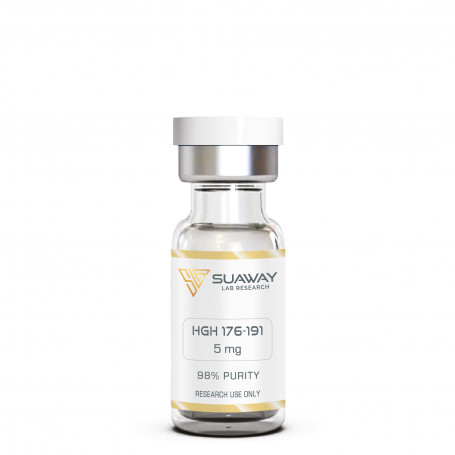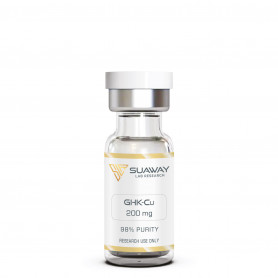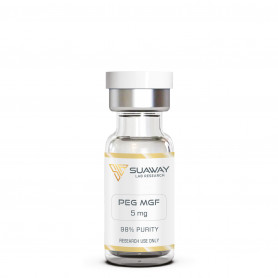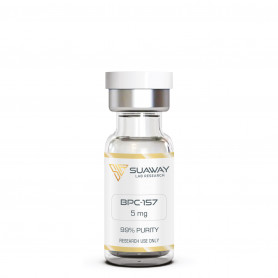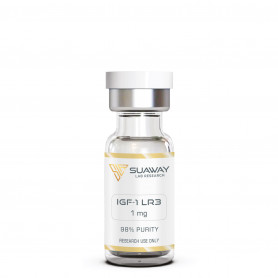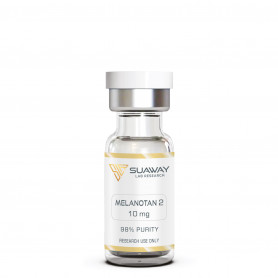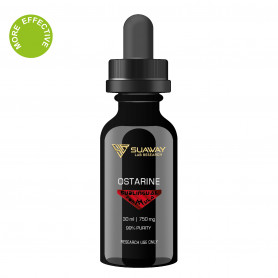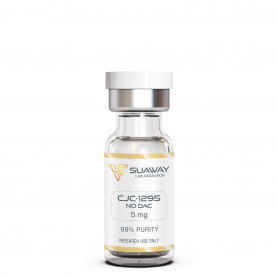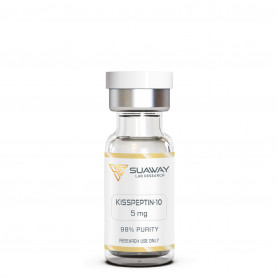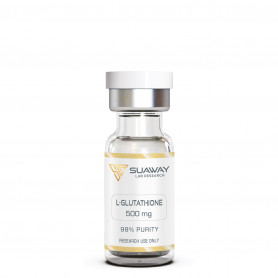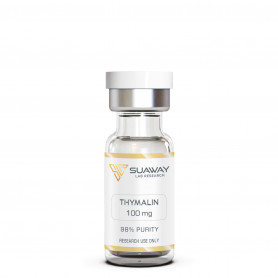HGH 176-191 - 5 mg
HGH Fragment 176-191 is a fragment of natural human growth hormone that has been chemically synthesized (HGH). Because of its capacity to hasten the breakdown of fat, it is sometimes referred to as the "lipolysis fragment." It has been proven to help decrease blood sugar levels and accelerate cartilage repair without boosting long-bone development, raising IGF-1 levels, or modifying insulin sensitivity. These benefits may be achieved without affecting the body's ability to respond to insulin.
HGH FRAG 176-191 has a significant influence on the following:
- Energy level and endurance
- Strengthens ligaments, joints, and bone tissue, which makes the skin seem better; improves the overall appearance of the body
- The increase in lean muscle mass as a result of an indirect and catabolic action that suppresses lipogenesi
- Stimulates lipolysis activity, leading to increased fat loss
Description
STRUCTURE
Sequence: H-Tyr-Leu-Arg-Ile-Val-Gln-Cys-Arg-Ser-Val-Glu-Gly-Ser-Cys-Gly-Phe-OH
Molecular Formula: C78H125N23O23S2
Molecular Weight: 1812.12 g/mol
CAS: 66004-57-7
Peptide Purity: Greater than 98%.
Other details: No TFA Salt
Storage: Lyophilized peptide must be stored at -20°C and peptide solution at 4°C.
HGH 176-191 has good oral and excellent subcutaneous bioavailability.
DESCRITPION
The amino acids 176-191 located at the C-terminal of HGH are responsible for the production of a protein peptide hormone that belongs to the GH (growth hormone) class. This hormone is known as HGH frag 176-191. Studies indicate that HGH frag 176-191 is designed to mimic the way that natural human growth hormone regulates the breaking down of fat, but it does so at a faster rate and without the undesirable side effects on blood sugar and cell proliferation.
In point of fact, it has been discovered that the HGH frag 176-191 is 12.5 times more powerful than HGH that has not been changed. HGH frag 176-191, which is sometimes referred to simply as HGH frag, is a product that is manufactured in the laboratory for those who want to reduce the most resistant fat deposits. It has the exceptional fat-burning capability and may function without suppressing the appetite of the individual using it.
This shortened version of human growth hormone, which functions like that of unmodified HGH, aids in the process of metabolizing fat and prevents the production of fatty acids and other lipids in the human body. On the other hand, it has a direct impact on the adipose tissue, more especially the adipose fat cells, and it amps up the lipolysis effect. As a result, the individual's metabolism burns fat at a quicker and more efficient rate. In other words, HGH frag 176-191 is an alternative for shedding excess fat that is superior to the traditional form of human growth hormone.
Additionally, it has been shown that HGH frag 176-191 has anti-aging characteristics because it is capable of increasing the creation of IGF-1 levels in the body.
Because it is solely a component of HGH, it does not compete with other hormones for the human growth hormone receptors, which means it does not contribute to conditions like hyperglycemia. Studies have shown that taking HGH frag 176-191 leads to not only a reduction in body fat but also a rise in lean body mass, improved quality of sleep, a boost in protein synthesis, an increase in bone mineral density, and acceleration of weight loss.
The hypoglycemic effects of human growth hormone (HGH), often known as reducing blood sugar, are predominantly caused by the c-terminal end of the protein via research conducted on animals. After testing at least six distinct fragments produced from this region of HGH, researchers determined that fragment 176-191 is the synthetic derivative of HGH that is most successful at reducing levels of blood sugar. This impact is a secondary one, and it is caused by a persistent rise in the levels of plasma insulin. The use of fragments 176-191 as a therapy for both prediabetes and type 2 diabetes is something that has garnered considerable attention recently.
Due to the findings of tests conducted on mice, fragments 176-191, also known as the "lipolysis fragment," were shown to have significant fat-burning and weight-loss characteristics. It is hypothesized that this effect is brought about by an increase in the synthesis of beta-3 adrenergic receptors, also known as ADRB3 receptors. It is well established that agonist activity at ADRB3 directly accelerates the rate at which fat is burned in adipose tissue and is also accountable for thermogenesis in skeletal muscle. Mice that have had their DNA altered such that they no longer express ADRB3 do not react to the lipolysis effects of human growth hormone (HGH) or fragment 176-191.
Studies have shown that the increased fat burning that is associated with fragments 176-191 has a direct correlation with increased energy expenditure and, as a result, weight loss. This has led to an almost 50% reduction in the amount of weight gain that obese animals experience over three weeks. It is interesting to note that the effects on weight loss were only seen in obese mice, while lean mice maintained normal body weight, on average, even when they were exposed to fragments 176-191. These results suggest that there are other regulatory mechanisms for lipolysis that, when body weight is at or near optimal, may override the action of ADRB3, opening up possibilities for further investigation into energy homeostasis.
Even though the lipolysis characteristics of fragments 176-191 are the primary reason for its attention, the peptide is now being studied for a variety of additional potentially beneficial effects. It is important to note that research published in Korea in 2015 found that fragment 176-191 has the potential to boost the effects of hyaluronic acid injections on cartilage regeneration.
According to research conducted on rabbits, weekly injections of fragments 176-191 boost laboratory measurements of cartilage formation. Furthermore, co-administration of the peptide with hyaluronic acid (HA) causes results that are much more significant. In a similar vein, the researchers concluded that the use of fragments 176-191 either alone or in conjunction with HA is effective in lessening the impairment caused by osteoarthritis.
Increased insulin resistance, diabetes, acromegaly, malignancy, hypertension, and edema are some of the potential adverse effects that have been linked to the usage of human growth hormone (HGH) and its derivatives for weight loss. This has given rise to some cause for worry.
When compared to the placebo, IV and oral administration of Fragment 176-191, which was investigated in a research that was published in 2013 in the Journal of Endocrinology and Metabolism, did not result in any changes in the following variables:
- Glucose tolerance
- Glucose levels
- Insulin sensitivity
- IGF-1 levels
According to the findings of this meta-analysis, fragments 176-191 may provide many of the advantages that are associated with human growth hormone (HGH), but without the adverse effects that are often associated with it. It is important to note that while human growth hormone (HGH) has anabolic effects on muscle, fragment 176-191 was purposefully chosen because of their capacity to completely avoid these effects. This must be done to guarantee that the peptide will have the desired lipolysis effects without causing acromegaly or any of the other diseases that are often connected with the administration of HGH. According to the results of studies conducted on mice, fragment 176-191 does not stimulate cell growth.
REFERENCES
R. Ferrer-Lorente et al., "Combined effects of oleoyl-estrone and a beta3-adrenergic agonist (CL316,243) on lipid stores of diet-induced overweight male Wistar rats" [PubMed]
F.M. Ng, J. Bornstein "Hyperglycemic action of synthetic C-terminal fragments of human growth hormone" [PubMed]
M.A. Heffernan et al. "Increase of fat oxidation and weight loss in obese mice caused by chronic treatment with human growth hormone or a modified C-terminal fragment" [PubMed]
M.M. Habibullah et al., "Human Growth Hormone Fragment 176–191 Peptide Enhances the Toxicity of Doxorubicin-Loaded Chitosan Nanoparticles Against MCF-7 Breast Cancer Cells" [PMC]
J.E. Brinkman et al., "Physiology, Growth Hormone" [PubMed]
V.S. Ayyar "History of growth hormone therapy" [PubMed]
C.S. Reh et al., "Somatotropin in the treatment of growth hormone deficiency and Turner syndrome in pediatric patients: a review" [PubMed]
K. Smith et al., "Treatment with Recombinant Growth Hormone Is Associated with Modest Improvement in CD4 Lymphocyte Reconstitution in HIV-Infected Persons on Antiretroviral Therapy: Results of ACTG A5174" [PMC]
G.Y.W. Ma et al., "The mechanism of the hyperglycaemic action of synthetic peptides related to the C-terminal sequence of human growth hormone" [ScienceDirect]
L. Napolitano et al., "Growth hormone enhances thymic function in HIV-1–infected adults" [PMC]
M. Plana et al., "The reconstitution of the thymus in immunosuppressed individuals restores CD4-specific cellular and humoral immune responses" [PMC]
J. Svensson et al., "Long-term efficacy and safety of somatropin for adult growth hormone deficiency" [PubMed]
DISCLAIMER
This product is intendend for lab research and development use only. These studies are performed outside of the body. This product is not medicines or drugs and has not been approved by the FDA or EMA to prevent, treat or cure any medical condition, ailment or disease. Bodily introduction of any kind into humans or animals is strictly forbidden by law. This product should only be handled by licensed, qualified professionals.
All product information provided on this website is for informational and educational purposes only.

